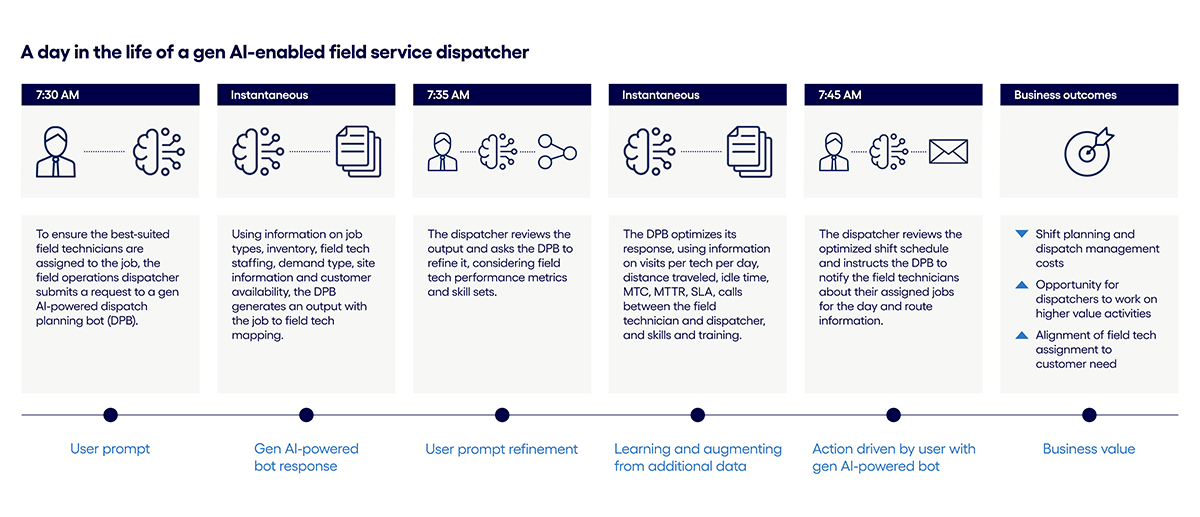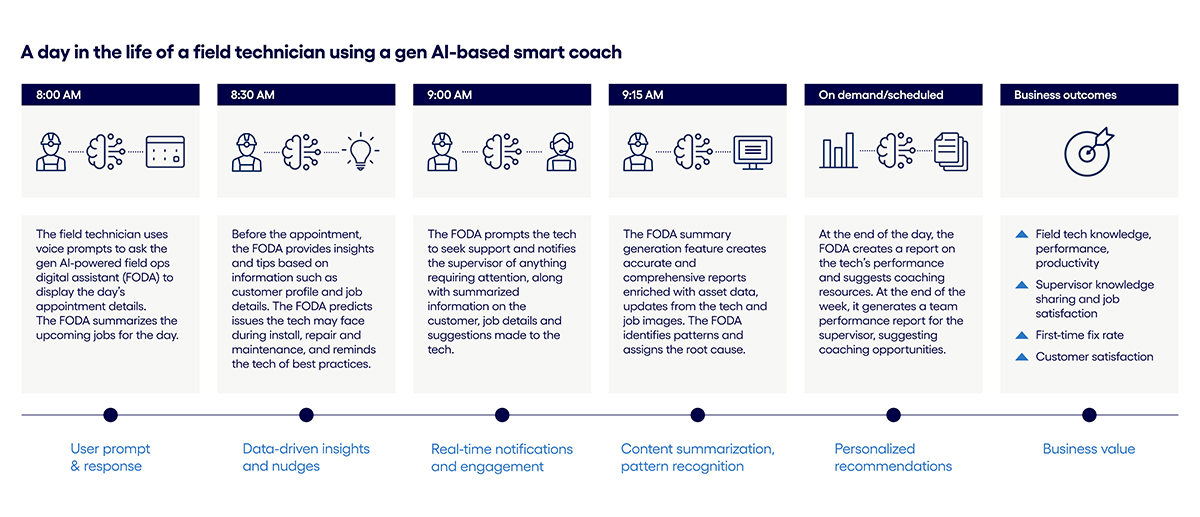June 12, 2024
Field operations is critical to CSPs. Enter gen AI
Here’s a look at three areas in which communications service providers can dramatically improve field operations with gen AI.
For many customers, losing access to the internet, cell service, cable or satellite network is an existential and costly event. This is why fast-acting, efficient and effective field operations in the telecommunications industry is so vital.
The problem is, field operations for communications service providers (CSP) is also an extremely intricate function to run. CSPs need to ensure work order information is complete and accurate, needed equipment and accessories are available at the right place and time, and junior technicians can get the support they need when servicing and supporting customers.
When such challenges are not handled correctly, it not only results in a poor customer experience, but it also leads to operational overhead. In one assessment of a leading North American CSP, non-effective worktime for the field operations function ranged as high as 38%.
Leading CSPs have been using rule-based automation, artificial intelligence (AI) and machine learning (ML) in field operations to drive operational efficiencies. But now we’re seeing CSPs deploy generative AI in their field operations, which will elevate these operational efficiencies to a whole new level.
Gen AI has the potential to simplify tasks by optimizing and automating various CSP field operations functions, thereby improving field operations productivity, enabling data-driven decisions, predicting outcomes, and prescribing and driving actions.
Let’s take a look at three areas in which CSPs can dramatically improve field operations with generative AI: scheduling and dispatch operations, technician support and customer self-service. By doing so, they can cut costs, optimize workforce planning, enable operational agility, and boost both employee and customer experience.
In the dispatcher’s seat: optimizing shift composition
Field technician scheduling and dispatch plays a critical role in running efficient field operations. Schedulers and dispatchers must balance demand with not just field technicians’ availability but also numerous other internal and external factors.
Although field service management software handles some of these needs, dispatchers and staff schedulers still struggle to create schedules that effectively respond to continuously shifting variables.
Dispatchers can take advantage of gen AI models that not only analyze numerous parameters—such as workload distribution, shift patterns, and field techs’ skill level and preferences—but also adapt to unforeseen circumstances and optimize shift composition. With these capabilities, CSPs can maximize productivity, optimize the in-house vs. vendor technician ratio, minimize labor costs and improve technician satisfaction. Additionally, generative AI can automate the scheduling process, saving time and effort.
Figure 1
In the field: smart coaching for field technicians
Field technicians often require assistance from supervisors or specialized colleagues when working on install, maintenance and repair jobs. If that assistance doesn’t come in a timely manner, they end up spending more time on the job or needing a follow-up appointment to complete the job. This results in a subpar customer experience and higher costs for the CSP.
Although CSPs have knowledge management tools to aid field technicians, generative AI can offer more guided assistance to field techs. A gen AI-driven smart coach can help field techs both prior to starting a job and during a job, providing insights and nudges to bridge skills gaps, and offer timely assistance and personalized recommendations. It can also be a vital tool once the job is complete because it can ensure the right root cause is assigned while closing the job.
Our clients often point to the challenge of inaccurate assignment of root causes. Often, field techs select root causes from a drop-down menu at the end of the job, and the temptation is to choose the first or easiest option listed in their rush to close the work order. Gen AI can help by summarizing the job details and assisting with root cause assignment by recognizing patterns in job descriptions and resolution details.
Figure 2
At the customer premises: better self-help with virtual field assistants
Truck rolls are a necessary part of CSP field operations. There will always be situations that warrant dispatching a field technician to a customer location for install, repair and maintenance jobs. However, there are also plenty of cases where customers can resolve issues with guidance from their CSP.
Most CSPs have customer-facing virtual assistants. But by augmenting these virtual assistants with gen AI, these tools can guide customers on a wider array of service configuration and activation tasks and resolve service anomaly issues. Not only does this reduce time to value for customers, but it also reduces truck rolls. Beyond solving the immediate issue, the virtual field assistant could also elevate the customer experience with product recommendations based on prior learning and experience.
Figure 3
Moving forward with gen AI for field operations
Here are three steps CSPs can take to start or accelerate their gen AI field operations journey:
1) Identify gen AI use cases that materially elevate the field operations journey. CSPs should identify gen AI use cases that will create and deliver distinct, significant incremental value. This assessment should include both use cases that currently utilize traditional AI/ML and ones that are net new.
Certain use cases will need to be put on the back burner until underlying technology and regulatory landscapes mature. These include those involving complex decisions, safety considerations and legal implications, as well as use cases that specifically benefit from human oversight.
The key is to start by focusing on field operations use cases that gen AI can handle optimally. Then, categorize and prioritize these use cases based on impact, feasibility and ease of implementation (i.e., quick wins, big bets).
2) Set up data capabilities and practices for gen AI. A big factor in the feasibility and ease of gen AI use case implementation is data: the availability, ownership and readiness of field operations data, as well as the CSP’s overall data capabilities, including data infrastructure, data literacy/fluency and data processes.
To implement a use case such as the smart coach described above, field operations will need to integrate data from systems most likely owned by other business functions, such as human resources (i.e., performance management and learning and development systems).
Leading CSPs with advanced data capabilities are better equipped to support gen AI. Others can catch up by establishing a roadmap for their data infrastructure, making their data processes gen AI-ready, and training and empowering their field tech personnel to be fluent in handling data.
3) Approach implementation decisions with well-informed perspectives. When it comes to implementation, it mostly comes down to the decision of procuring a commercial off-the-shelf (COTS) gen AI application/model and providing the necessary data, context and training or custom-building the gen AI application/models.
When answering the build vs. buy question, CSPs should start with the concept of business value and broader objectives and think beyond the output of the system. Key considerations include in-house talent, time to market/value requirements and total cost of ownership.
Additionally, CSPs should evaluate the foundational model, complexity and methodology involved in making the AI models fit the needs of the field operations use cases (i.e., prompt /context learning, fine-tuning). The answer isn’t to do nothing or take a wait-and-watch approach. CSPs should work with the right external experts, consultants or partners to help research and make decisions if they don’t want to go it alone.
With the right balance of quick-win and big-bet field operations gen AI use cases—along with data capabilities and applications and models that enable implementation—field operations will have the foundational elements they need to start or accelerate their gen AI journey. Sustained success comes with executive support, vision, strategy and roadmaps that enable field operations to weave gen AI throughout their processes.
The journey will require a strong commitment, and few CSPs will choose to do this entirely on their own. CSPs must identify and work with trusted partners that will support them through shared financial success models.
Naresh Nirmal is a Senior Director in Cognizant Consulting, focusing on Communications, Media, and Technology (CMT) industry. His expertise lies in enabling digital-native, zero-touch total experience leveraging Data & Analytics, AI, Cloud Computing, and Digital Engineering.
Ameet Sulibhavi Prahlad is a Senior Consulting Manager within Cognizant’s Communications, Media, and Technology (CMT) consulting practice. His expertise includes strategic advisory, digital transformation, product, and program management.
Latest posts
Related posts
Get actionable business Insights in your inbox
Sign up for the Cognizant newsletter to gain actionable AI advice and real-world business insights delivered to your inbox every month.




















